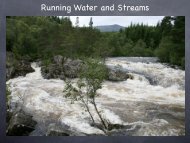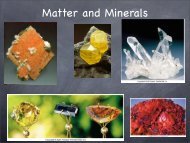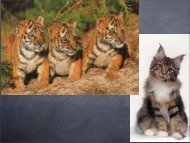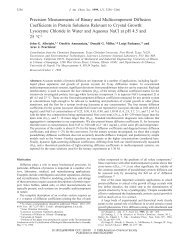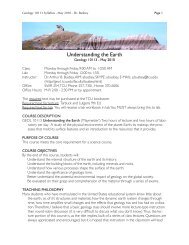Just Published the book...see Preface here... - Texas Christian ...
Just Published the book...see Preface here... - Texas Christian ...
Just Published the book...see Preface here... - Texas Christian ...
Create successful ePaper yourself
Turn your PDF publications into a flip-book with our unique Google optimized e-Paper software.
Slattery_Contemp.Environ.Issues_01E_Text01_FM.pdf 12/21/07 1:13 PM Page iContemporaryEnvironmental IssuesMichael C. Slattery<strong>Texas</strong> <strong>Christian</strong> University
Slattery_Contemp.Environ.Issues_01E_Text01_FM.pdf 12/19/07 12:36 PM Page iiClip art symbols courtesy of <strong>the</strong> Integrated and Application Network (ian.umces.edu/symbols/, University of Maryland Center for Environmental Science with <strong>the</strong>irpermission.Cover Image:Image copyright Jan Martin WillUsed under license from Shutterstock, Inc.Copyright © 2008 by Michael C. SlatteryISBN 978-0-7575-4248-0Kendall/Hunt Publishing Company has <strong>the</strong> exclusive rights to reproduce this work,to prepare derivative works from this work, to publicly distribute this work,to publicly perform this work and to publicly display this work.All rights reserved. No part of this publication may be reproduced,stored in a retrieval system, or transmitted, in any form or by anymeans, electronic, mechanical, photocopying, recording, or o<strong>the</strong>rwise,without <strong>the</strong> prior written permission of <strong>the</strong> copyright owner.Printed in <strong>the</strong> United States of America10987654321
Slattery_Contemp.Environ.Issues_01E_Text01_FM.pdf 12/19/07 12:36 PM Page iiiFor my son, LiamIsn’t this a marvelous planet?
Slattery_Contemp.Environ.Issues_01E_Text01_FM.pdf 12/19/07 12:36 PM Page iv
Slattery_Contemp.Environ.Issues_01E_Text01_FM.pdf 12/19/07 12:36 PM Page vContents<strong>Preface</strong> ixAcknowledgmentsxiiiCHAPTER ONETree Huggers, Lab Coats, and Doing <strong>the</strong> Right Thing 1A Brief History of Conservation and Environmentalism in <strong>the</strong> United States 2Environmental Stewardship and Environmental Ethics 5Putting a Price on Nature and Its Services 7Scientists and Environmental Advocacy 9Scientific Uncertainty 10Concluding Thoughts 11CHAPTER TWOHuman Population Growth 15Fundamentals of Population Growth 17Human Populations 22Concluding Thoughts 28CHAPTER THREEThe Environmental Impact of Our Search for Energy 31Introduction 32Powering Our Planet: Current Energy Sources 32Energy, Society and <strong>the</strong> Environment 35W<strong>here</strong> To Now? 54Concluding Thoughts 55v
Slattery_Contemp.Environ.Issues_01E_Text01_FM.pdf 12/19/07 12:36 PM Page viviContentsCHAPTER FOURAir Pollution and Atmospheric Deposition 57Defining Air Quality 58The Criteria Pollutants 61The Air Quality Index (AQI): A Guide to Air Quality and Your Health 65National Trends in Criteria Levels 68NO x , So x , and Acid Deposition 70Concluding Thoughts 76CHAPTER FIVEStratospheric Ozone Depletion 77Formation, Measurement, and Function of Ozone 79Ozone Depletion Over <strong>the</strong> Poles 82The Recipe for Ozone Loss 86What Is Being Done? 90Concluding Thoughts 91CHAPTER SIXGlobal Warming 93CO 2 and <strong>the</strong> Greenhouse Effect 94Is Global Warming Real? 101Predicting Future Trends in CO 2 and Temperature 105Possible Effects of Global Warming 109Moving Forward 113Concluding Thoughts 116CHAPTER SEVENDeforestation 119What Is Deforestation? 120Rates of Tropical Deforestation 122Agents of Deforestation 126Drivers of Deforestation 128Case Study: Deforestation and Forest Recovery in Costa Rica 130Concluding Thoughts 134
Slattery_Contemp.Environ.Issues_01E_Text01_FM.pdf 12/19/07 12:36 PM Page viiContentsviiCHAPTER EIGHTBiodiversity: The Sixth Mass Extinction 135How Many Species Exist? 137Biodiversity Principles 138Global Diversity and Hot Spots 139Species Loss and Extinction 143Characteristic of Threatened Species and Conservation Strategies 145The Value of Biodiversity 149Protecting Biodiversity: The Endangered Species Act 151Case Study: Biodiversity on Hawaii 153Concluding Thoughts 157CHAPTER NINESoil Degradation 159The Science of Soil 161Soil Erosion: Natural vs. Accelerated 164Our Agricultural Status: Feeding <strong>the</strong> World 168How Much Soil Are We Really Losing? 170Impacts of Soil Loss 173Progress in Soil Conservation 175Concluding Thoughts 176CHAPTER TENThe Water Crisis 179The Hydrological Cycle 180Groundwater Aquifers 183How Much Water Do We Use? 187Water Quality 190A New Way Forward: Focusing on Watersheds 194Concluding Thoughts 196
Slattery_Contemp.Environ.Issues_01E_Text01_FM.pdf 12/19/07 12:36 PM Page viiiviiiContentsCHAPTER ELEVENEarth’s Carrying Capacity and OurEcological Footprint 199Introduction 200What Is Carrying Capacity? 200Is Population Really <strong>the</strong> Driver of Environmental Degradation? 202Calculating Your Ecological Footprint 203Concluding Thoughts 208CHAPTER TWELVEA Reason to Be Optimistic 211
Slattery_Contemp.Environ.Issues_01E_Text01_FM.pdf 12/19/07 12:36 PM Page ix<strong>Preface</strong>Our relationship with <strong>the</strong> Earth is changing at an unprecedented rate. The pace of changeis accelerating not only from our advancing technology, but from world populationgrowth, economic growth, and increasingly frequent collisions between expanding humandemands and <strong>the</strong> limits of <strong>the</strong> Earth’s natural systems. Scientists now say we are in a newstage of <strong>the</strong> Earth’s history, <strong>the</strong> Anthropocene Epoch, when we humans have become <strong>the</strong>globe’s principal agent of change. We frequently hear that current global consumption levelscould result in a large-scale ecosystem collapse by <strong>the</strong> middle of <strong>the</strong> century, and thatenvironmental catastrophe looms ahead unless major changes are made in a short periodof time.Whe<strong>the</strong>r or not current human pressure on <strong>the</strong> Earth’s ecosystems threatens ourfuture as a species, one thing <strong>see</strong>ms certain: we cannot continue to consume at nor<strong>the</strong>rnlevels indefinitely. To begin to shift towards a “sustainable society” scenario requires significantaction now on a range of issues. Fortunately, people are capable of changing <strong>the</strong>ir© The New Yorker Collection 2006 David Sipress from cartoonbank.com. All Rights Reserved.ix
Slattery_Contemp.Environ.Issues_01E_Text01_FM.pdf 12/19/07 12:36 PM Page xx<strong>Preface</strong>behaviors and values. Often <strong>the</strong>se changes stem from exposure to new information orexperiences. I have <strong>see</strong>n this first-hand in Costa Rica, w<strong>here</strong> I take students from my universityon a three-week trip each spring. Here, <strong>the</strong>y get to <strong>see</strong> widespread environmentaldegradation (deforestation, soil erosion, and overgrazed landscapes) juxtaposed againstpristine rainforests teaming with wildlife. Many begin to grasp, for <strong>the</strong> first time, <strong>the</strong>extent of our impact on <strong>the</strong> Earth’s ecosystems, as well as <strong>the</strong> challenges we face in tryingto strike a balance between development and conservation.I believe everyone should be exposed to such information and experiences, because itdevelops a level of environmental literacy that is necessary for dealing with <strong>the</strong> challengesof <strong>the</strong> 21st century. The sad truth, however, is that environmental literacy is almost nonexistentin formal education. At most universities, undergraduates are required to take a setof common courses—chemistry, physics, calculus, English, etc.,—that make up a “core” of<strong>the</strong> degree plan. Hardly anyw<strong>here</strong> do you <strong>see</strong> a required course in global environmentalissues, although issues related to <strong>the</strong> environment affect each of us in our daily lives. Ibelieve every citizen should become fluent in <strong>the</strong> principles of environmental science,demonstrating a working knowledge of <strong>the</strong> basic grammar and underlying concepts ofenvironmental wisdom. This <strong>book</strong> has been written with this goal in mind.Why am I writing yet ano<strong>the</strong>r environmental <strong>book</strong> when so many exist on <strong>the</strong> market?In short, I believe this <strong>book</strong> is different. Most of <strong>the</strong> traditional introductory texts aretoo broad, attempt to do too much, and have, in my opinion, become “environmentalencyclopedias” that are laden with too many facts about <strong>the</strong> environment. I have tried severaltext<strong>book</strong>s in my introductory course over <strong>the</strong> past decade, and during this time, I havebecome increasingly frustrated with students having to spend in excess of $100 for <strong>the</strong>se<strong>book</strong>s when we only cover half of <strong>the</strong> material in a typical 15-week semester course. A lotof <strong>the</strong> time, <strong>the</strong> best value students get out of a <strong>book</strong> is <strong>the</strong> money <strong>the</strong>y receive when <strong>the</strong>ysell it back to <strong>the</strong> <strong>book</strong>store! What I really wanted to create was a <strong>book</strong> that presents a candidanalysis of <strong>the</strong> top environmental issues <strong>the</strong> world currently faces: one that was inexpensive,informative, and made students think about how <strong>the</strong> environment affects <strong>the</strong>irlives and how <strong>the</strong>ir actions affect <strong>the</strong> environment. I always half-jokingly said I wanted a<strong>book</strong> that students could read in <strong>the</strong> bathtub. More importantly, I wanted a <strong>book</strong> that <strong>the</strong>ywould want to keep after <strong>the</strong> course is over!This <strong>book</strong> covers ten issues that I believe are <strong>the</strong> most pressing environmental issuestoday: population growth, energy, atmospheric pollution, ozone depletion, global warming,deforestation, biodiversity loss, soil degradation, water quantity and quality, and ourecological footprint. I chose <strong>the</strong>m after surveying <strong>the</strong> environmental studies faculty at myuniversity, asking <strong>the</strong>m a simple question: What environmental issues do we want ourstudents—all our students, and not just environmental science majors—to be conversantin? Interestingly, <strong>the</strong>re was almost unanimous agreement among <strong>the</strong> faculty on <strong>the</strong> issues,with one or two personal interest topics emerging. It is not an exhaustive list, nor is itmeant to be. Ra<strong>the</strong>r, my approach to writing <strong>the</strong> <strong>book</strong> was to cover <strong>the</strong>se key issues andcover <strong>the</strong>m well, providing <strong>the</strong> current state of scientific knowledge, yet written at a levelthat is digestible by <strong>the</strong> non-science major. However, adequate solutions to environmentalproblems also require well-informed ethical, aes<strong>the</strong>tic, political, and cultural perspectives,in addition to basic science and economics, and I have attempted to weave <strong>the</strong>se perspectivesthroughout <strong>the</strong> text. The following questions, in particular, are ones that I would likeyou to think about as you read <strong>the</strong> material:
Slattery_Contemp.Environ.Issues_01E_Text01_FM.pdf 12/19/07 12:36 PM Page xi<strong>Preface</strong>xi1. What (if any) are <strong>the</strong> ethical responsibilities of humans relating to <strong>the</strong> naturalenvironment?2. What is <strong>the</strong> role of science in <strong>the</strong> environmental debate?3. Is scientific research value-neutral?4. Does nature have intrinsic value?5. Are <strong>the</strong>re ethical principles that constrain how we use resources and modify ourenvironment?6. How do we achieve a balance between human values and interests and our obligationsand responsibilities to nature?In summary, it is my hope that upon completion of this <strong>book</strong>, you will: (1) understand<strong>the</strong> complexity of <strong>the</strong> delicately-balanced processes that shape <strong>the</strong> natural world; (2) understand<strong>the</strong> need to make informed and responsible decisions with regard to <strong>the</strong> developmentof <strong>the</strong> Earth; and (3) appreciate <strong>the</strong> notion of humans as <strong>the</strong> dominant species and <strong>the</strong> consequencesof human-induced changes to <strong>the</strong> environment.A NOTE ABOUT THE DIAGRAMSAs you flip through <strong>the</strong> pages of this <strong>book</strong>, you will no doubt notice that <strong>the</strong>re are veryfew photographs of soon-to-be extinct species or pollution pouring into our atmosp<strong>here</strong> orwaterways. You can find any number of those online or in <strong>the</strong> numerous glossy color textsthat are on <strong>the</strong> market or in libraries. Instead, <strong>the</strong> majority of <strong>the</strong> diagrams in this <strong>book</strong> areconceptual figures and data-rich graphs from <strong>the</strong> scientific literature that have been simplifiedand redrawn to tell <strong>the</strong> story. The illustrations convey important ideas—such as <strong>the</strong>relationship between carbon dioxide concentration and global warming projections, orbetween <strong>the</strong> amount of land required to feed humanity, population growth, and rates ofsoil loss. Some illustrations may <strong>see</strong>m light-hearted, but <strong>the</strong>y have all been chosen specificallyto ei<strong>the</strong>r inform or simply inspire. For ones that don’t reproduce well and black andwhite, we will keep an updated collection on our institute’s homepage; please go tohttp://www.ensc.tcu.edu for <strong>the</strong> link.
Slattery_Contemp.Environ.Issues_01E_Text01_FM.pdf 12/19/07 12:36 PM Page xii
Slattery_Contemp.Environ.Issues_01E_Text01_FM.pdf 12/19/07 12:36 PM Page xiiiAcknowledgmentsI am extremely grateful to <strong>the</strong> following people, each of whom helped in no small way: BarbaraBurkholder, for her valuable comments and editorial expertise; Stephanie Eady, forreading <strong>the</strong> manuscript and her creativity in preparing <strong>the</strong> diagrams; Jean Ellis, for herthoughtful and candid assessment of <strong>the</strong> first draft; Paul Gares, for his friendship and askingquestions no one else dare ask; at <strong>Texas</strong> <strong>Christian</strong> University, Ken Morgan, Richard Hanson,Nowell Donovan, Mike McCracken, Tony Burgess, Becky Richards, Leo Newland, and RayDrenner, for <strong>the</strong>ir support and friendship over <strong>the</strong> years; at Kendall/Hunt Publishing Company,Stephanie Aichle and Michelle Bahr; my wife Jan, for her support and putting up withlong nights in front of <strong>the</strong> computer; Terri Mabe, my administrative assistant, who keeps mefunctioning in more ways than she knows; and finally my students, who make driving in ona Monday morning well worth <strong>the</strong> commute!xiii
Slattery_Contemp.Environ.Issues_01E_Text01_FM.pdf 12/19/07 12:36 PM Page xiv




